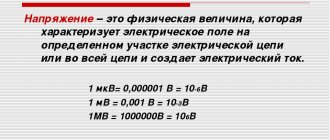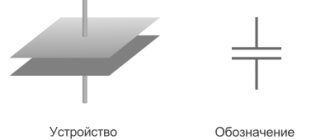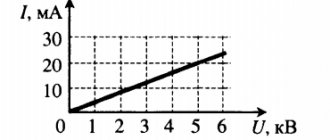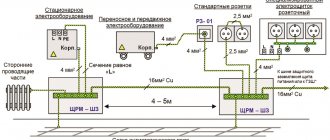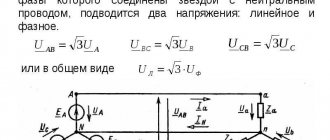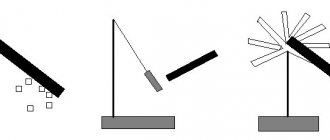Work of the electrostatic field
Let's consider the situation: charge q0 enters an electrostatic field. This electrostatic field is also created by some charged body or system of bodies, but we are not interested in this. A force acts on the charge q0 from the field, which can do work and move this charge in the field.
The work of the electrostatic field does not depend on the trajectory. The work done by the field when a charge moves along a closed path is zero. For this reason, the electrostatic field forces are called conservative
, and the field itself is called
potential
.
Determination of electrostatic potential
A body located in a potential field of forces (and an electrostatic field is considered potential) has potential energy, through which work will be done by the field forces. The work of conservative forces will be performed due to the loss of potential energy
Electrostatic potential is a special term in case of possible replacement of the general term in electrodynamics (scalar potential). Historically, in physics, the first appearance of the term “electrostatic potential” was observed, and the scalar potential of electrodynamics became its generalization.
Due to the fact that the potential (as well as potential energy) can be determined with an accuracy up to an arbitrary constant (and all quantities that can be measured: field strength, force, remain unchanged regardless of the choice of the constant value method) by a direct physical meaning (if quantum effects are not meant) it is not the potential itself that possesses, but the potential difference.
At the same time, it is generally accepted that other charges during such an operation are “frozen” (immobile at the moment of such movement (this implies imaginary, not real movement). Moreover, in rare cases, in order to remove ambiguity, certain “natural” conditions are used.
Figure 2. Electrostatic field potential. Author24 - online exchange of student work
For example, the potential is often determined in such a way that its value is equivalent to zero at infinity for any point charge. In such a situation, for any finite system of charges, a similar condition will be satisfied at infinity, and there will be no need to think about the arbitrariness of the choice of constant.
Potential
The "charge - electrostatic field" or "charge - charge" system has potential energy, just as the "gravitational field - body" system has potential energy.
A physical scalar quantity characterizing the energy state of the field is called potential
a given point in the field. A charge q is placed in a field, it has potential energy W. Potential is a characteristic of an electrostatic field.
Let's remember potential energy in mechanics. Potential energy is zero when the body is on the ground. And when a body is raised to a certain height, it is said that the body has potential energy.
Regarding potential energy in electricity, there is no zero level of potential energy. It is chosen randomly. Therefore, potential is a relative physical quantity.
In mechanics, bodies tend to occupy a position with the least potential energy. In electricity, under the influence of field forces, a positively charged body tends to move from a point with a higher potential to a point with a lower potential, and a negatively charged body, vice versa.
Potential field energy is the work done by the electrostatic force when moving a charge from a given point in the field to a point with zero potential.
Let us consider the special case when an electrostatic field is created by an electric charge Q. To study the potential of such a field, there is no need to introduce a charge q into it. You can calculate the potential of any point in such a field located at a distance r from the charge Q.
The dielectric constant of the medium has a known value (tabular) and characterizes the medium in which the field exists. For air it is equal to unity.
Working in an electric field. Potential
When a test charge q moves in an electric field, electric forces do work. This work for small displacement is equal to (Fig. 1.4.1):
| Figure 1.4.1. Work of electric forces with small charge movement q |
Let us consider the work of forces in an electric field created by a distributed charge that does not change in time, i.e. electrostatic field
The electrostatic field has an important property:
The work of electrostatic field forces when moving a charge from one point in the field to another does not depend on the shape of the trajectory, but is determined only by the position of the starting and ending points and the magnitude of the charge.
The gravitational field also has a similar property, and this is not surprising, since gravitational and Coulomb forces are described by the same relations.
A consequence of the independence of work from the shape of the trajectory is the following statement:
The work done by the electrostatic field forces when moving a charge along any closed trajectory is zero.
Force fields that have this property are called potential or conservative.
In Fig. Figure 1.4.2 shows the Coulomb field lines of a point charge Q and two different trajectories of movement of a test charge q from the starting point (1) to the ending point (2). A small displacement is highlighted on one of the trajectories. The work ΔA of the Coulomb forces on this displacement is equal to
Thus, work at small displacement depends only on the distance r between the charges and its change Δr. If this expression is integrated over the interval from r = r1 to r = r2, then we can obtain
| Figure 1.4.2. The work of Coulomb forces when moving a charge q depends only on the distances r1 and r2 of the initial and final points of the trajectory |
The obtained result does not depend on the shape of the trajectory. On trajectories I and II shown in Fig. 1.4.2, the work of the Coulomb forces is the same. If on one of the trajectories the direction of movement of the charge q is changed to the opposite, then the work will change sign. It follows that on a closed trajectory the work of Coulomb forces is equal to zero.
If the electrostatic field is created by a set of point charges, then when a test charge q moves, the work A of the resulting field, in accordance with the superposition principle, will be the sum of the work of the Coulomb fields of point charges: Since each term of the sum does not depend on the shape of the trajectory, then the total work A of the resulting field does not depend on the path and is determined only by the position of the starting and ending points.
The property of potentiality of an electrostatic field allows us to introduce the concept of potential energy of a charge in an electric field. To do this, a certain point (0) is selected in space, and the potential energy of the charge q placed at this point is taken equal to zero.
The potential energy of a charge q placed at any point (1) in space relative to a fixed point (0) is equal to the work A 10 that the electrostatic field will perform when moving charge q from point (1) to point (0):
| Wp1 = A10. |
(In electrostatics, energy is usually denoted by the letter W, since the letter E denotes field strength.)
Just as in mechanics, potential energy is determined up to a constant value, depending on the choice of the reference point (0). Such ambiguity in the definition of potential energy does not lead to any misunderstandings, since the physical meaning is not the potential energy itself, but the difference in its values at two points in space.
The work done by the electrostatic field when moving a point charge q from point (1) to point (2) is equal to the difference in the potential energy values at these points and does not depend on the path of charge movement and on the choice of point (0).
| A12 = A10 + A02 = A10 – A20 = Wp1 – Wp2. |
The potential energy of a charge q placed in an electrostatic field is proportional to the magnitude of this charge.
A physical quantity equal to the ratio of the potential energy of an electric charge in an electrostatic field to the value of this charge is called the potential φ of the electric field:
Potential φ is an energy characteristic of an electrostatic field.
The work A12 does to move electric charge q from the starting point (1) to the ending point (2) is equal to the product of the charge and the potential difference (φ1 – φ2) of the starting and ending points:
| A12 = Wp1 – Wp2 = qφ1 – qφ2 = q(φ1 – φ2). |
In the International System of Units (SI), the unit of potential is the Volt (V).
| 1 V = 1 J / 1 C |
In many problems of electrostatics, when calculating potentials, it is convenient to take the point at infinity as the reference point (0). In this case, the concept of potential can be defined as follows:
The field potential at a given point in space is equal to the work done by electric forces when removing a unit positive charge from a given point to infinity.
The potential φ∞ of the field of a point charge Q at a distance r from it relative to a point at infinity is calculated as follows:
As follows from Gauss's theorem, the same formula expresses the field potential of a uniformly charged ball (or sphere) for r ≥ R, where R is the radius of the ball.
For a visual representation of the electrostatic field, along with lines of force, equipotential surfaces .
A surface at all points of which the electric field potential has the same values is called an equipotential surface or a surface of equal potential.
Electrostatic field lines are always perpendicular to equipotential surfaces.
The equipotential surfaces of the Coulomb field of a point charge are concentric spheres. In Fig. 1.4.3 shows pictures of field lines and equipotential surfaces of some simple electrostatic fields.
| Figure 1.4.3. Equipotential surfaces (blue lines) and field lines (red lines) of simple electric fields: a – point charge; b – electric dipole; c – two equal positive charges |
In the case of a uniform field, equipotential surfaces are a system of parallel planes.
If the test charge q made a small movement along the field line from point (1) to point (2), then we can write:
| ΔA12 = qEΔl = q(φ1 – φ2) = – qΔφ, |
where Δφ = φ1 – φ2 – change in potential. this implies
This relationship expresses in scalar form the relationship between field strength and potential. Here l is the coordinate measured along the field line.
From the principle of superposition of field strengths created by electric charges, the principle of superposition for potentials follows:
φ = φ1 + φ2 + φ3 + …
How to determine the sign of potential
When solving problems, a lot of confusion arises when determining the sign of potential, potential difference, and work.
The figure shows tension lines. At which point in the field is the potential greater?
The correct answer is point 1. Let us remember that the tension lines begin on a positive charge, which means the positive charge is on the left, therefore the leftmost point has the maximum potential.
If a field is being studied that is created by a negative charge, then the field potential near the charge has a negative value; this can be easily verified if a charge with a minus sign is substituted into the formula. The further away from the negative charge, the greater the field potential.
If a positive charge moves along the tension lines, then the potential difference and work are positive. If a negative charge moves along the tension lines, then the potential difference has a “+” sign, and the work has a “-” sign.
Think for yourself: the work and potential difference will take negative or positive values if the charge is moved in the opposite direction relative to the tension lines.
Electrostatic field
The electrostatic field is a field formed by electric charges that are stationary in space and unchanging in time (provided that there are no electric currents). The electric field is thus considered to be a special type of matter associated with electric charges and transmitting the effects of charges on each other.
Thus, if there is a system of charged bodies in space, then at each point there will be recorded the existence of a force electric field, determined through the force acting on a test point charge placed in this field. The test charge must be negligibly small so as not to affect the characteristics of the electrostatic field.
Help with student work on the topic Potential in Electrostatics
Coursework 460 ₽ Essay 250 ₽ Test paper 230 ₽
Get completed work or consultation with a specialist on your educational project Find out the cost
Figure 1. Electrostatic field. Author24 - online exchange of student work
An electric field is called homogeneous in a situation if its intensity vector is the same at all points of the field. The main characteristics of the electrostatic field are the following:
- tension;
- potential.
The force lines of such a field have the following properties:
- They will always be closed, that is, starting on positive charges and ending on negative ones. They do not intersect or touch each other.
- The greater the tension, the greater the line density. In other words, the field strength is directly proportional to the number of field lines crossing a unit area area, whose location will be perpendicular to the lines.
Need advice on your academic work? Ask a question to the teacher and get an answer in 15 minutes! Ask a Question
Note 1
The electrostatic field has a direct effect on any number of charges, and a complex system of interactions will arise. The system strength can be viewed in terms of superposition, so the total effect of the number of charges is the vector sum of all field strengths.
In accordance with this, the more such lines, the more intense the force effect. In metals (and other conductive materials) there will be no field strength (due to the counter-directed action of the field of free charge carriers located in the structure of the crystal lattice).
In fact, the forces are quickly equalized, the absence of current is detected, and the tension lines are not able to penetrate such a conductor. In addition to vector quantities, the field can be described by scalar values (ideal case) taken at each point. Such values in electrostatics characterize the field potential.



